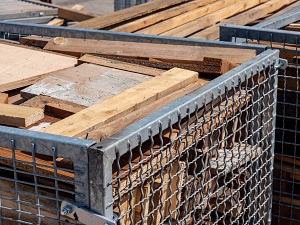Construction site fire safety focuses on key areas of fire protection including housekeeping, fire extinguisher availability, the maintenance of safe evacuation routes and the storage and handling of combustible materials.

Fire prevention and protection is critically important on any construction site. Before construction begins, a fire protection program, as well as an emergency response plan, should be developed and all construction workers should be trained on the procedures. Every demolition, renovation and construction project is different and the fire protection plan should be designed specifically for the site.
The best fire safety plan starts with fire prevention, to ensure a safe construction site, however, when fire prevention measures fail, it is just as critical to be prepared to prevent as much damage as possible by extinguishing the fire quickly and ensuring every worker can evacuate quickly and safely.
OSHA Standard 1926.151(a)(3) Smoking shall be prohibited at or in the vicinity of operations which constitute a fire hazard, and shall be conspicuously posted: "No Smoking or Open Flame."
Be aware that the smoking policy at any construction site may be stricter than the OSHA standard.
Prevent fires by following proper storage, handling and housekeeping requirements. Good housekeeping is key to fire prevention, but poor housekeeping can lead to small fires that get out of control quickly.
Never let combustible scrap, rubbish, and waste materials accumulate where they can become fuel for a fire. Oily rags, wipes, or towels that have been used for cleaning off solvents and residue should be stored in covered metal containers to prevent an ignition source. Dispose of combustible wastes and empty all bins at least once a day to avoid a dangerous creation of fire or explosion hazards.
OSHA Standard 1926.25(b) Combustible scrap and debris shall be removed at regular intervals during the course of construction. Safe means shall be provided to facilitate such removal.
Weeds and grass in outdoor open yard storage areas must be kept down. A procedure for the periodic cleanup of the entire outdoor storage area must be established.

To ensure the quick and easy access of fire extinguishing equipment in the event of an emergency, OSHA provides these specific guidelines. For each 3,000 square feet of the construction area, at least one of the following must be available as a fire extinguisher.
- portable fire extinguisher, rated not less than 2A
- 55-gallon open drum of water with two fire pails
- garden-type hose line 1/2-inch in diameter, not longer than 100 feet, equipped with a nozzle, capable of discharging a minimum of 5 gallons of water per minute with a minimum hose stream range of 30-feet horizontally
If flammable liquids, combustible liquids or flammable gas are present at the construction site, then a portable fire extinguisher, rated not less than 10B, must be provided.
Travel distance from any point at the site to the nearest fire extinguisher must not be more than 100 feet.
In multi-story construction builds there must be fire extinguishers on every floor and at least one fire extinguisher located adjacent to the stairway.
If cold weather is a concern, fire extinguishers and water drums must be protected to prevent freezing.
Portable fire extinguishers should be made available at convenient and accessible locations in any outdoor storage area.
If the building under construction includes the installation of an automatic sprinkler system, it must be placed in service as soon as legally possible following the completion of each story. During demolition or renovation, any existing automatic sprinkler systems must be kept in service for as long as possible.
Fire walls and exit stairways, required for the building under construction, must be given priority during construction. Fire doors, with automatic closing devices, must be hung on openings as soon as practicable.
Even though a construction site is a work environment that changes on a daily basis, it is still extremely important that at any given time all personnel on site be alerted immediately if there is an emergency. A fire alarm system must be installed that will alert workers at the construction site and the local fire department in the event of an emergency.
Exits must be kept clear throughout construction to allow for a quick and safe evacuation, if needed. Temporary buildings must not be constructed in such a way that they block or partially block an exit. Material storage cannot obstruct any exit.

If not stored, moved, handled, or used properly, combustible materials can pose ignition hazards on construction projects. Combustible materials must not be piled higher than 20 feet. Combustible materials that are stored outdoors cannot be within 10 feet of a building or structure.
During demolition that involves combustible materials, charged hose lines, supplied by hydrants, water tank trucks with pumps or similar, must be available.
OSHA Standard 1926.150(b)(1) A temporary or permanent water supply, of sufficient volume, duration, and pressure, required to properly operate the firefighting equipment shall be made available as soon as combustible materials accumulate.
If equipment is being used that is powered by an internal combustion engine, this equipment must be located so that the exhausts are well away from combustible materials.
Battery-powered lighting equipment, used for or near the storage, handling or use of flammable gases or liquids, must be approved for hazardous locations.

.jpeg)
.jpg)
